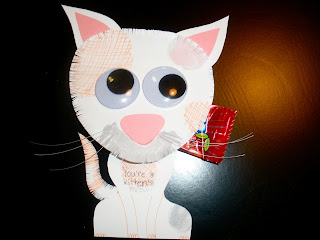The idea behind polymer clay earrings is fairly simple, but managing to create two identical earrings involves a lot of trial and error.
Materials:
Polymer Clay (I like Sculpey)
Earring Hardware
Polymer Clay Glaze
Paintbrush
Baking Sheet
Parchment Paper (Optional)
 1) Conditioning your clay
1) Conditioning your clayPolymer clay needs to be conditioned before use. First, you have to warm up the clay. I like to do this by putting the clay I'm going to use in a ziploc bag and then sticking that ziploc bag in my pocket for about five minutes. Next, I squish it with my fingers until it feels like playdough. If the clay seems to hard, you can use clay softener.
2) Roll your pieces

Since you're going to be making two identical earrings, it is important to use the same amount of clay for each earring. If you want, you can use a gram scale for more precise measurements, but the less expensive alternative is to simply eyeball it. When rolling out your clay, make sure the two pieces are the same length and width.
3) Shaping your pieces

Shape your clay pieces to your desired shape. Cut your piece where you want to insert your hardware.
4) Adding your hardware
When inserting the earring post it is important that the clay covers the cap. If it isn't covered, your earrings can separate from the post after the clay is baked. Earring backs are a little more tricky. There are three types of earring backs. Earnut backs don't work. Earring clutches work better, but they're big and don't allow for a lot of flexibility. Plastic backs are your best bet, but plastic melts in the oven. I simply stick the plastic backs in the clay and let it bake. A minute or two after I take the earrings out of the oven (while the plastic is still melty), I stick in an extra post as to mold the inside of the earring. Take the post out after two or three minutes or the post will become permanent.
5) Bake your earrings!

Follow the instructions on your clay packages. Generally it's 30 minutes at 275
°.
6) Cooling
Let your earrings cool for a few minutes. This would be the part where, if you're using plastic backs, you stick in the earring posts.
7) Applying glaze
 Dangle your earrings from somewhere, anywhere. This will prevent the glaze from gathering in unwanted places. Now you can apply the glaze. Follow the directions on the bottle. Most glazes require a half hour between coats, so keep that in mind. Make sure your coats are thin.
Dangle your earrings from somewhere, anywhere. This will prevent the glaze from gathering in unwanted places. Now you can apply the glaze. Follow the directions on the bottle. Most glazes require a half hour between coats, so keep that in mind. Make sure your coats are thin.
8) Let dry
I like to let my earrings dry for a couple hours. Overnight is ideal.
9) Wear!
Thanks, Hannah for being my model!!!





























